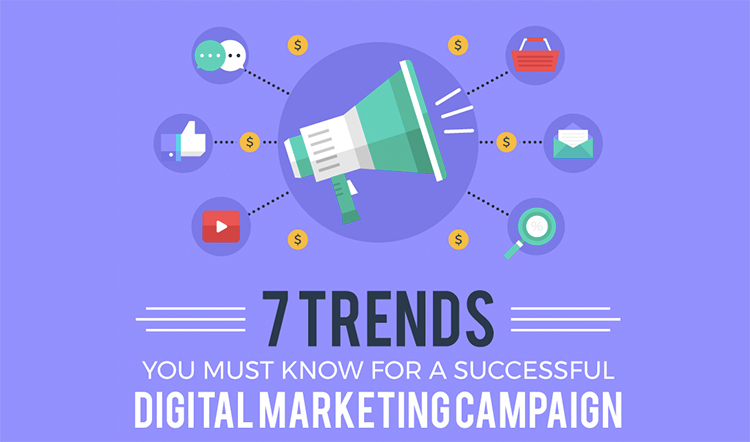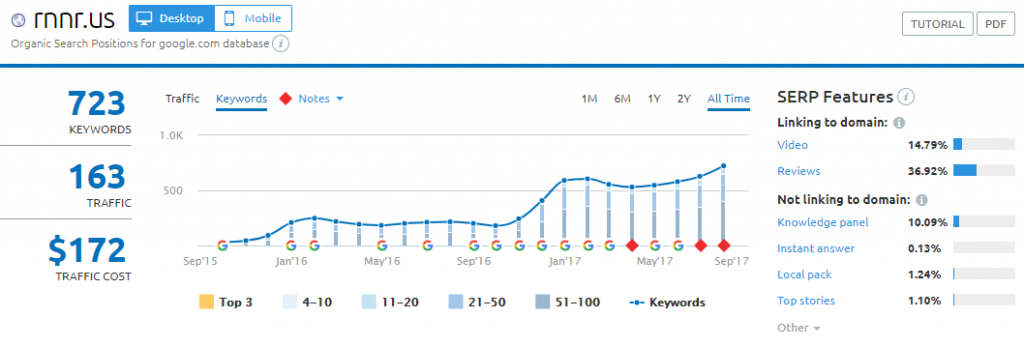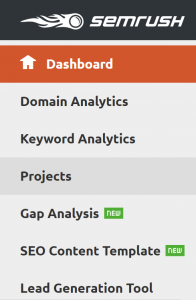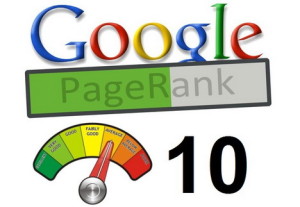The post Digital marketing campaigns: 7 trends to watch (infographic) appeared first on Inside Social Media.
]]>
Tactics to master on search, mobile, video, email, ads & more
Post by Josh Wardini
 The Internet is constantly changing to accommodate dynamic consumers who continue to look for better ways to improve their online experience. This dynamic attribute affects digital marketing as well. Brands, small and big businesses, and marketers need to be updated with the latest changes in digital marketing if they want to rise through the Google ranks.
The Internet is constantly changing to accommodate dynamic consumers who continue to look for better ways to improve their online experience. This dynamic attribute affects digital marketing as well. Brands, small and big businesses, and marketers need to be updated with the latest changes in digital marketing if they want to rise through the Google ranks.
This year has brought some surprising changes to digital marketing. For example, influencers became more prominent on social media and other online platforms. They served as a major game-changer for companies hoping to build partnerships for a better shot at their target audience.
Another trend that is undoubtedly shaping digital marketing in 2019 is the apparent dominance of mobile devices over desktops. As the quality of handheld devices and even wearables continue to improve, more marketers are taking steps toward creating mobile-friendly campaigns.
This is just the start of mobile device dominance. A lot of experts are expecting more consumers to lean toward smartphones and tablets in the near future.
Companies should also begin to market themselves as secure and safe brands to transact online. This new trend is sparked by increasing concerns regarding online privacy and safety. Needless to say, people are now only willing to trust brands that can guarantee the safety of the data they gather.
Digital marketing in the near term
What’s next for digital marketing?
For now, signs suggest that companies need to begin focusing more on appealing to the audience’s emotions more than anything else. Simply put, relatable and engaging content will be more effective for the rest of the year and beyond. This is just one of the many trends that will shape digital marketing campaigns in the future.
We’ve compiled a comprehensive list of the latest digital trends that every marketer and brand should know. If you’re hoping to propel your company to rise against the competition, the following infographic will be worth the look.

Even if you’re just hoping to understand what consumers will be looking for next, you’ll definitely want to browse through this list of trends. Check it out online.
The post Digital marketing campaigns: 7 trends to watch (infographic) appeared first on Inside Social Media.
]]>The post All the webmaster SEO tools on SEMRush appeared first on Inside Social Media.
]]>
 Ijust got my hands on a Guru subscription to SEMRush so I haven’t had a lot of time to figure it out. SEMRush delivers Google Analytics, Google Webmasters, Buffer, HootSuite, Moz, and SpyFu in one powerful and useful SEO and SEM dashboard.
Ijust got my hands on a Guru subscription to SEMRush so I haven’t had a lot of time to figure it out. SEMRush delivers Google Analytics, Google Webmasters, Buffer, HootSuite, Moz, and SpyFu in one powerful and useful SEO and SEM dashboard.

Like you, I pieced together Google Analytics, Google Webmasters, Buffer, HootSuite, SpyFu, and a compilation of other little online tools. That was, until Olga reached out to me to give me full access to the entire suite of tools that make up the newest iteration of SEMRush.

I’ve played a little with Moz and never quite made it work for me because none of my personal sites were eCommerce sites, so I never really understood why I needed to pay between $99-$599/month. However, I can really see the value of spending that sort of money, from $99-399/month. This tool that can help me write SEO-optimized copy, domain analytics, keyword analytics, organic and paid keyword audits, SERP position tracking, brand monitoring, backlink audit, “SEO ideas,” and even SEOquake, a Chrome plugin that offers inline SEO audits of sites, SERP overlays, domain comparison, and link examination.

What’s more, since I never use paid ads, the strong focus on organic SEO analysis and auditing help me get outside of my own head and easily see which of the keywords that bubble up on my sites are really driving traffic to my sites rather than wasting all my time writing content that isn’t organically competitive or viable no matter how badly I want these keywords and organic search results to come my way.
 While it’s always exciting to see when desirable keywords come up reliably in the SERP top-10, it’s also fascinating for me to slice and dice the content as well. SEMRush allows you to look the success (and failure) of your site and its content based not only on whether you make the top-5 in the most obvious keywords (chris abraham, gerris corp) but also in keywords you like.
While it’s always exciting to see when desirable keywords come up reliably in the SERP top-10, it’s also fascinating for me to slice and dice the content as well. SEMRush allows you to look the success (and failure) of your site and its content based not only on whether you make the top-5 in the most obvious keywords (chris abraham, gerris corp) but also in keywords you like.
What’s even more exciting than getting a top-ten result in a very specific search is to get a keyword hit that may not be in the top-5 but results in a huge volume of visitors — many more visitors than you might have been aware of.
SEMRush can do this because, behind the scenes, after properly setting up a project (which is domain/URL-driven), you stitch SEMRush together using all the tools that you’ve been using, singly, before: Facebook, Twitter, Google+, Instagram, YouTube, Google Analytics, Google Webmasters/Webmasters Tools, and I am sure SEMRush’s proprietary analytics tools as well.
The value added of bringing all of these tools and tool kits together allow me to audit all the hard work I have been doing optimizing my content and writing content and writing for search and viability, and after all of the social media sharing and blogging, it’s very interesting to see how all of this hard work has been interpreted.
It’s sort of like newspaper reviews and online comments when you’re producing a play or a movie: sometimes all this data can be really valuable and useful but it can also end up being such a distraction. Obsessing about what SEMRush reports about my properties will just take me away from creating good content myself.
 What SEMRush tries to be is a go-to dashboard where you can quickly do a pulse check on how your campaigns are doing before you close the tab and get back to work.
What SEMRush tries to be is a go-to dashboard where you can quickly do a pulse check on how your campaigns are doing before you close the tab and get back to work.
A couple of really interesting tools that are in alpha and beta are SEO Ideas and Link Building tools that actually give you the tools and the project management process by which you can actually find allies in the online space and presumably partner with these sites or even work on doing some mutual link-building or mutual guest-posting.
These are my first steps and first foray into SEMRush — I am hoping that its dashboard and the way it handles projects will easily allow me to replace all the free online tools that I hack together ad hoc, Google Analytics, Google Webmasters, Buffer, HootSuite, SpyFu, etc.
Have you had a chance to try out SEMRush yourself? Why not just pop your domain URL into the widget below and see the sort of rabbit hole I have gone down a short week ago when Olga gave me the keys to the SEMRush kingdom.
The post All the webmaster SEO tools on SEMRush appeared first on Inside Social Media.
]]>The post Improve your Google search results today appeared first on Inside Social Media.
]]>
Follow the tips below to speed up and clean up your site.
Do you use a CDN? Do you blog? Do you optimize your images? Do you pay proper homage to the Google gods? And other tricks of the SEO trade
 There are so many things you can do on your own site today — starting now — that will help you in real ways with Google Search and your search results on Google’s SERP. Here are nine things you can do starting today to improve your search results and the quality of your visitors’ experiences.
There are so many things you can do on your own site today — starting now — that will help you in real ways with Google Search and your search results on Google’s SERP. Here are nine things you can do starting today to improve your search results and the quality of your visitors’ experiences.
Because so many people presumably make so much money “doing SEO,” there’s a lot of confusion as to what search engine optimization is and all the little things that you can do right now, today, to improve your the results on your SERP — search engine results page. OK, let’s start.
- Go Rewrite As Many Titles as You Have Time For Right Now: According to Moz, “Google typically displays the first 50-60 characters of a title tag. If you keep your titles under 60 characters, our research suggests that you can expect about 90% of your titles to display properly.” You should keep the titles concise, but also descriptive. Don’t be cute. All of my titles are cute and I waste them. Remember, all anybody knows about any of your pages — including Google’s spiders and bots — is the title of your pages. So, if your title currently is “Check Out My Latest Project” you really should actually describe the subject of the blog post or site page. Be descriptive and be specific.
- Don’t Let Google Define Your Page Descriptions for You — Do It Yourself: You don’t have to care about the description of your page. There are two ways to get a little control: rewrite your first paragraph to describe what your page is about exactly the way journalists and reporters are supposed to, in the first paragraph. According to Moz, “Meta descriptions can be any length, but search engines generally truncate snippets longer than 160 characters. It is best to keep meta descriptions long enough that they’re sufficiently descriptive but shorter than that 160-character limit.” So, if you don’t actually write a meta description, Google will always steal your first 160 characters. If your site (say, a WordPress blog) allows you to write a summary or your page allows you to define a description, do it. And, if you come up with an excellent summary for your page, that description should include similar turns of phrase and keywords in both your title and your full content. And, if you really like your summary description, then please be sure to integrate it into your writing. Make it better, make it newer, and take it out of “archive,” which is what Google does if you don’t update your site’s content and copy every once in a while.
- Add 500 Words to a Product or Service Page by Close of Business: Over 90% of all the outdated, over-synthesized, or over-edited sites I have seen just don’t have enough text for Google to really get a handle on. Everybody’s trying to be so succinct. I blame the elevator speech for this. We’ve boiled our business plans and our visions and mission statements down so far — a réduction, if you will — that they’re worthless to both Google and to someone who actually wants to use your website — your corporate site, your only cornerstone, your online HQ, your Internet everything! Why are you keeping it so brief? Why are you being so sneaky? Why don’t you sit down, fire up a stogie, pour yourself a deep one, and let’s talk about who you are, what you really do, why you’ve been so inspired, and what your real and true capabilities are. As in long form. And, if all of this text and all these words break the aesthetics of your proper website, then be sure to share all of these cigar and rum moments on your blog or on a deeper, secondary page.
- Link Keyword Phrases from Content Pages to About and Offerings Pages at Once: You probably haven’t done the most effective thing you can do on your own site right now: Every time you see a mention of your products, your services, or the names of your employees, executives, and cast of characters, you should hyperlink them all to the pages on which they live. For example, I will link my name, Chris Abraham, to my page on insidesocialmedia.com. See, it’s as easy as that. You should really do it.
- Add ALT Text to All Your Photos and Images Right this Minute: All modern content management systems (CMS) have some place to customize all the images on your site. Even if you don’t know how, ask your geek. If you still have your website designer on speed dial, maybe you can encourage your web designer or your template-developer to help you out. Most downloadable templates these days make it easy to associate words with photos and words with images. Now, baby we can do it take the time, do it right, we can do it, baby, do it tonight! Why didn’t your web developer do it? Laziness. It’s probably even in your contract. You didn’t care at the time. The more pretty images, the better. But now you need to care. Why? Because Google can only read — and index and return results for — text so if a lot of your site is made up of images and graphics and graphics of text (are you kidding me), then they’re all invisible to Google. You always need to look at your site as if you were blind or visually impaired. By the way, here is how a search engine sees your website.
- Connect Your Site Immediately to Bing Webmaster Tools and Google Webmasters: You really should have done this already. Click me: Bing Webmaster Tools and Google Webmasters — also, if you don’t have an SEO tool for your site, look into Yoast SEO for Drupal or Yoast SEO for WordPress. They have the tools required to make it super-simple to make all the proper connections you need. Also, bonus points: Google Analytics.

- Optimize Your Images If That’s Something You Can Easily Do Soon: Don’t assume that your content management system automagically takes your 4MB and 2MB and 10MB and 14MB(!)images and squishes them down from your crazy 8 megapixel cameraphone photos to images that are especially optimized for the web. All of your 5184 × 3456 pixel images really need to be brought down to 1600×800 pixels — or even smaller. If you can’t get your images under control via your server or your CMS, then you’re going to need to use Photoshop or something else. If your images are too big, your site will take too long to load; and, if you make your visitors’ experience sluggish, then Google will punish you and your search results will suffer.
- Get a Faster Web Hosting Company and Learn About Caching and CDNs: Google be taxing! If your site isn’t mobile native or friendly, you’ll face a tax! If your images are huge and fat and take forever to load: tax! And, if your site isn’t responsive in the hand-off between when someone clicks on your Google Search result and the time when she gets to your page, then tax! If your JavaScript and CSS is cluttering up the page (instead of actual content): tax! So, you’ll need to spend some money on getting a fast server, a server with RAM and an SSD HD, super-close access to the Internet backbone, with the ability to scale if you get a flood of visitors, or not get flooded if someone else on your shared server scores a sticky meme. More than the $3.95 that you’re spending now or the half-assed server setup that your CMS website service providers have you on (they need to make as much delta as possible, right, we’re capitalists, after all). And, even then, you need to learn about how to make your slow-ass database-backed websites, your WordPress or Drupal or whatever site, faster through caching. WordPress caching’s pretty easy. And then, since you can’t be in all places at once, a content delivery network (CDN) allows you to distribute your site and all its contents across the globe. I have sorted out how to use CloudFlare for free over on my “I don’t want to be fat, sick, and weak forever” blog, RNNR. Not only do CDNs help quicken up your site, they also make proximity to the server a non-issue. If your servers are in Northern California and someone’s checking out your site in London would need to burrow through MAE-East to get to it. But, with a CDN, presumably there’d be a working copy of RNNR somewhere in the UK. All of this is worth looking into. At least for SEO, at least for Google. Because, if all things are equal, then the speed, quickness, and responsiveness of your site is going to be the x-factor.
- Write a Blog Post About Everything On Your Site As Soon As You Can: See what I am doing right now? You might think that we’re doing all of this to help you. Well, yes, but I’m also doing it to help myself. Because Google loves engagement and popularity and visits and social shares and reshares and retweets. I have been taking my own advice since 1999. I do this as a burnt sacrifice and offering to the altar of Google Search. You should start blogging. Not for me, not for fame, not to pursue your writer’s life, but for Google. To Google Be the Glory Forever and Ever, Amen. And, don’t start your blog in WordPress.com or on Medium.com or on Blogger/Blogspot, but on your own domain. Like, on Gerris Corp’s site, the blog post is gerriscorp.com/blog — you should do it like this.
- Use Images in Your Blog Posts (not like this one). You can find plenty of free ones at Pixabay and on Flickr under a Creative Commons license and on dozens of other sites.
Good luck. This should get you through the next day. Let me know if I missed anything down in the comments. I hope it’s useful for you. If you won’t do it, make me do it. I actually consult on SEO — check me out over on www.chrisabraham.com or email me at [email protected].
The post Improve your Google search results today appeared first on Inside Social Media.
]]>The post Google wants a warm meal every day instead of a fancy Christmas dinner but once-a-year appeared first on Inside Social Media.
]]>
 Why do search professionals scatter like roaches when the kitchen light comes on? Why is everyone acting so sneaky all the time? Why do SEO professionals skulk around dark alleyways, offering their search engine services in furtive, hurried whispers? What’s up with that?
Why do search professionals scatter like roaches when the kitchen light comes on? Why is everyone acting so sneaky all the time? Why do SEO professionals skulk around dark alleyways, offering their search engine services in furtive, hurried whispers? What’s up with that?
Don’t we all know that Google Search is a somniloquist! Whenever he is able to catch some shut-eye, a nanosecond at a time, he cries out in his slumber, “feed me . . . feed me Seymour.”
Not only is Google a Glutton, but he’s always hungry — and a picky eater, too. In a perfect world, all of Google’s food would be steamy hot, bold with spices and herbs, and nutritionally rich.
If you and I don’t constantly develop ways to provide Google with all the taste-sensations, fresh out of the pan, out of the oven, and then beautifully-plated, then Google’ll definitely reheat leftovers — hell, he’ll fish out the meals ready to eat (MREs).
But, honestly, Google would always prefer to eat healthy. Quality over quantity. Google would love to get enough fiber, enough vitamins and minerals, enough healthy fat and presentation.
The internet webosphere is like greater Washington, DC on a weekday lunchtime: food trucks everywhere! Yes, also restaurants, fast food, fast-casual, brown bags of tuna prepared at home, hot dog and burrito carts, office cantinas, take out places, and by-the-pound buffet joints.
Before the age of the food truck, there were some carts offering haute cuisine, but it wasn’t until the rise of the food truck when the entire power structure lunch at least, was set: dirty water dogs, burgers, buffet salad, or sit down restaurant food.
The barrier to entry was pretty impossible save for a few rich folks doing it for vanity or experienced folks doing it for shareholder value. And the paperwork, licensing, and all the other food-hoops required.
But DC is big, hungry, and wants all the taste-sensations, fresh out of the pan, out of the oven, and then beautifully-plated; and we want our lunch to be delicious, steamy hot, bold with spices and herbs, and nutritionally rich.
Because DC’s already hungry, DC’s only somewhat a snob! The majority of folks who work in DC during the work week is balancing between time, price, proximity, healthiness, preference, and deliciousness. And all you need to do is discover what as many of those things are and cook to order.
You can feed Google. You can even become Google’s favorite type of food, snack, lunch, sandwich, dessert, cheat, breakfast, dinner, late-night bite. But you, like every great cook, every great chef, cannot just make something awesome once.
You don’t need to make the Guinness Book of World Records and then done. SEO is not one-and-done! It’s feeding the newsroom rather than just getting a novel out of you just to have written a novel.
I’m a pretty good cook. In fact, I have made some amazing things perfectly actually once (remember that Bûche de Noël I made that one time with the powdered sugar snow, the branches, the ganache and cake?).
But Google prefers hot fresh donuts over even my Bûche de Noël once it’s a week old.
So, stop sneaking around and stop trying to be way fancier than you’re able to provide every single day.
Google wants your content food as hungrily as it wants the the President’s latest transcript or the top headlines from the New York Times. But only if it’s at least as fresh, nutritional, and as tasty as the other good stuff around it.
I sell web site and branding services for my buddy Mike McDermott of Bash Foo and the vast majority of all your competitors can’t cook at all; and those who can, only cook a couple times a year at the most, give or take a couple years.
While the bar is super-low for 99% of your competitors, the bar is nosebleed-high for the remaining 1% who have all that sorted out. Also, since the webinternetosphere is a global market, mostly, that 1% is still a very large number.
Google doesn’t think so. Google thinks that it really sucks that only 1% of all online content-providers offer more than complete crap. Those 1% (who are generally the same people who are in the 1% in the real world), the best-of-breed in Google Search, are the same people that Google, in it’s love of the little guy and it’s passion for egalitarianism and equal access based on an impossibly-low barrier to entry, fights hard to disempower.
Google wants diversity — your diversity — but Google also knows that the people who search using Google are also impatient, intolerant to junk results, unwilling to suffer ugly, unable to trust a site that is rarely if every updated, unsure about sites that haven’t kept up with technology and design (so many of our websites are the equivalent of shag carpet, orange appliances, avocado green counter tops, old stove, and a tiny ancient fridge with no stainless or granite or backsplash to be seen anywhere!
Come up with a content marketing plan that is the equivalent of my simple peasant meal of eggs, chicken, greens, fish, herbs, and spice, and then run with it. Make it every day. Just make sure it’s fresh, it’s honest, it’s make with the best ingredients possible, and you don’t cut corners. Put too much gravy or cream or béarnaise on your dish and maybe that’s an attempt to hide a bunch of flaws. Gilding the lily is almost always a way to give an often deceptively attractive or improved appearance.
Cook simply, show your work, make it basic, use good ingredients, plate it lovingly, deliver it quickly (you all need faster sites), and you’ll become Google’s favorite — at least when it comes to the particular fare you’re offering, within your niche.
Now, your turn. It’s essential to think of Google as hungry and in need of what you — or anybody — have to contribute (Google’s like Wikipedia that way, but unlike Wikipedia, you’re allowed — encouraged – to create your own page!)
So, that box you gladly checked when you finished your website three years ago isn’t a completed task. How dare you! It was just the very first version of a constantly expanding, growing, changing, and living collection of documents.
OK, after all of this talk about food, I’m ready to eat — ready, set, Publish!
Via Biznology
The post Google wants a warm meal every day instead of a fancy Christmas dinner but once-a-year appeared first on Inside Social Media.
]]>The post Ultimate SEO Checklist – 75+ effective techniques (Infographic) appeared first on Inside Social Media.
]]>Post by Nirav Dave
![]() Let’s agree on the fact that SEO is a vast digital landscape that is forever evolving. Search engine optimization is the key factor that can improve your site’s visibility and ranking on search engines. So getting a grasp on what SEO techniques work and what tactics are no longer effective is essential for the growth and success of your online business.
Let’s agree on the fact that SEO is a vast digital landscape that is forever evolving. Search engine optimization is the key factor that can improve your site’s visibility and ranking on search engines. So getting a grasp on what SEO techniques work and what tactics are no longer effective is essential for the growth and success of your online business.
Moreover, SEO itself consists of many on-page as well as off-page ranking factors (200 to be exact), and keeping a tab on all these strategies can be an overwhelming task. Additionally, you might find SEO guides that claim to be the “Ultimate,’’ and while some of the techniques employed may work, overall such methods are hardly ever useful.
Thus, if you have searched the Internet trying to find out the best SEO techniques to implement on your site and have not found one that best suits your business, no worries, because here is a genuine, up-to-date Ultimate SEO Checklist that can be used for all online businesses.
What this SEO checklist is about
This guide is a well-researched and comprehensive SEO checklist that consists of the best on-page and off-page tactics that you need to know about. Plus, to make it easier for you, this guide comes in the form of an infographic that you can download (and pass along to your colleagues) for free!
So check out this SEO checklist infographic and implement these 75-plus techniques on your website to improve your site’s visibility, ranking and resulting traffic!
Killer SEO Checklist [Infographic] by the team at Capsicum Mediaworks, LLP — click to enlarge
The post Ultimate SEO Checklist – 75+ effective techniques (Infographic) appeared first on Inside Social Media.
]]>The post The more the messier for search success appeared first on Inside Social Media.
]]>
 You need to spend only 20% of the time you do on your content marketing and marketing SEO than you’re doing — at least for now. Be quick, be messy, be pedestrian, maybe even turn off your Grammatik and your Autocorrect. Churn out five-times the amount of content you’ve been writing then hit publish and walk away for a couple days. Then, feel free to get all anal retentive on your content — but only with the stuff you plan to add to your portfolio. Leave everything else as close to as-is as possible. Please.
You need to spend only 20% of the time you do on your content marketing and marketing SEO than you’re doing — at least for now. Be quick, be messy, be pedestrian, maybe even turn off your Grammatik and your Autocorrect. Churn out five-times the amount of content you’ve been writing then hit publish and walk away for a couple days. Then, feel free to get all anal retentive on your content — but only with the stuff you plan to add to your portfolio. Leave everything else as close to as-is as possible. Please.
America voted Donald J. Trump 45th president of the United States. To many, Trump’s campaign was a mess — but it worked because it spoke directly to so many people right under our nose and in their own language. Away from school marms and hall monitors. For better for worse, the internet reflects the way people search and write and speak when they’re on their own, away from the grammar police and your thesis advisor.
When I was recruited into the elite digital team at Edelman Public Affairs, they made me take a grammar test. It was an HR requirement even though I was brought on board by an EVP. To this day, our reports, our memoranda, even our emails need to reflect exceptional professionalism.
Unfortunately, all this esprit de corps is mostly wasted in your pursuit of search engine optimization (SEO) ranking and in your content marketing campaigns. Trump speaks at a 6th grade level, and should we all. In fact, weren’t we all trained to aim at the 6th or 7th grade Flesch–Kincaid readability?
As I have said many times before, Google is mostly literal. Google is not your book editor or your doctoral advisor, Google is your everyman. Google is mostly populist. Actually Google is whatever and whomever you want Google to be; however, when it comes to money, you’re more likely to get 20,000 nickels than one thousand-dollar bill. Everyman is where it’s at.
When I wrote for AdAge, back in the day, circa 2008-2009, they did the most delightful thing, though I don’t know how SEO-aware or SEO-focused they were about this. They published whatever I wrote for them immediately upon receipt and then, a couple-days, if not a week later, they went back and put it through the full archive, for perpetuity, let’s not embarrass the Advertising Age reputation, editing.
I always knew that my work would enter the world fully-flawed just like me. With the kind of mistakes that everyone, including me, makes all the time, especially during search. The genius of letting a few days go by before the first deep editing is that all the mistakes, all the informality, and the colloquialisms of we the rabble, pre-spit-polishing and detailing.
And then Google gets in there, indexes, and maybe gets lazy, doesn’t come back in a couple-few days later, doesn’t care too much about the diff between initial draft written by a PR and marketing professional. The final article worthy of consideration is restored to a perfection there never was, by a hyper-vigilant school marm cum hall monitor cum editor.
In my previous life, I used to be a professional film photographer. 35mm slides through Nikon bodies and Nikkor glass. The creative process only took up 20% of my time while developing, sleeving, editing, sorting, labeling, logging, packing, mailing, marketing, selling, and waiting took the other 80%. No, I am not missing a piece. Since I was a slide shooter, I rarely spent too much time in Photoshop doing post-production. I only had light, film, glass, and filter. Someone else did their magic in the darkroom or on a Macintosh Quadra 950.
Same with blogging or any other type of creative behavior. When I was shooting, I was giving 100% but it was still only 20% of the work required to deliver a finished product to the client.
I have upwards of 100,000 slides in archival sleeves in my storage area — but only 4,000 have made me any money and only 400 of those slides made my portfolio: 20 sleeves of 20 slides per.
But back in the day, all 100,000 of those images sat in tall steel file cabinets at Corbis (née The Stock Market) and Pacific Stock, filed away and indexed. While only 4,000 made me royalties and only 400 made me money, 100,000 were always in play.
While only 4% of all my work was considered profitable — and that’s high — nobody ever knew which 4%. And though only .4% ever made it into my portfolio, 250x that had potential.
I want you to write at least five times as much content as you are. Blog content, not ephemeral tweets or facebooks.
Populism 2017 — stop trying to appeal to your Headmaster or the Yale Law Journal, the future’s in that other bubble, a bubble where your choice of words and how you write them color your writing as much as does the content.
Each and every telegraphist has his or her own unique style and pattern when transmitting a message, called their “fist,” identifiable to other telegraphers. The same can be said about your and your words and your writing. Allow your content to become as unique in style and pattern as possible. Your flaws will become your own personal style and you will actually begin to attract people who are outside of Phi Beta Kappa and the National Honor Society — were they ever your perfect customers in the first place?
Via Biznology
The post The more the messier for search success appeared first on Inside Social Media.
]]>The post How to Combine SEO, Social, and Content Strategy for Supercharged Results appeared first on Inside Social Media.
]]>Post by Adi Englander

Does your marketing incorporate a mix of content, social, and SEO? If not, you aren’t as competitive as you could be. These three disciplines need to pull their weight together for a brand’s marketing to be healthy and effective. As a worst-case scenario, a weak link among them can render your marketing ineffective.
Once you start allowing SEO, social, and content to feed off each other, you’ll begin earning a noticeable competitive advantage. How do you combine all three? Good question!
Let’s begin by highlighting the combination of SEO and Content, and then I’ll move on to adding Social Media to the mix. By the end, you’ll see how all three work together to achieve amazing results.
Combining SEO and Content
Although content marketing and SEO are often viewed as two distinct disciplines, the reality is that they are actually two sides of the same coin. Content wants to be seen. Attention is what content is made for, after all! SEO gives content the attention it needs.
On the other side of the coin, SEO needs content to do its job effectively. So as you can see, content and SEO need each other.
Here are some best practices to keep in mind:
- High Quality Content = SEO Gold
We all know that once upon a time, SEOs were able to get away with publishing content that was overly-focused on keywords. The goal back then was to manipulate search engines for high rankings. Obviously, manipulation tactics don’t work today.Yes, keywords are still important (as I’ll mention later.) But keep in mind that audiences demand high quality, human-centric content rather than content that was created simply for keyword stuffing.
Unfortunately, as we sink into the online ocean of quantity, we often forget about the importance of quality.
Content that is informative, crystal clear, and well-written encourages readers to remain on your site and consume your content longer. As your site’s bounce rate decrease, you’ll raise your chances of higher SERP rankings.
Another reason why high-quality content is vital for SEO is that it attracts backlinks, which can eventually boost your SERP rankings. While you can’t control the number of people who link to your site, you can certainly encourage backlinks by creating useful, high-quality content.
As your content is being created, you should always ask, “Would I link to this content if I were the audience?”
- Make Your Content Unique
This is an offshoot of high-quality content, but it’s worth mentioning by itself. From an SEO perspective, unique, original content gives search-engine crawlers something they haven’t indexed 100 times already. Uniqueness is good for search engines, and therefore it’s good for you.
Your content should also be unique from your audience’s perspective. Even the most well-written articles and best-produced videos will be ignored if your audience has already seen similar content elsewhere.
No matter how you look at it, originality is crucial.
- Choose Evergreen Topics When Possible
Evergreen topics – i.e., subjects that are always fresh and relevant – can give your content higher search rankings for the long haul. And when your content has high search rankings, it will have more visits. With more visits come the potential for more links, which lead to even higher search rankings, and on and on. Here are some evergreen content ideas for help getting started.
- Still Do Keyword Research
Some marketers have heard that keywords are no longer important in SEO. After all, keywords aren’t even required in your title tag or heading tags any more.Nonetheless, the notion that “keyword research isn’t needed” is actually untrue. To effectively combine your content marketing with your SEO, don’t skip keyword research. Although your content needs to be human-centric and valuable, weaving the right keywords into your content is important for giving it exposure.
What is true is that old methods of doing keyword research are no longer effective. As Nate Dame explained in a SearchEngineLand article, “Traditional, old-school keyword research produces long lists of words and phrases — with their relative search traffic figures — that can dramatically improve nothing about an SEO strategy.”
For more information on effective keyword research, here’s an informative guide.
- Include Internal Linking
For your content marketing to effectively work with your SEO, weave internal linking into your content. This will not only help search engines crawl your site and help you rank higher for certain terms, but it will also give readers of your content a better experience.
Adding Social Media to the Mix
Similarly to the relationship of SEO and content, social media and SEO are also highly effective when combined. Here are some best practices:
- Advertise on Social Channels
Yes, definitely pay to play. It’s worth it. Many SEO practitioners don’t think of the SEO benefits that come from social advertising. Combining the syndication abilities of Facebook, Instagram, Twitter, Pinterest, and others, your content can achieve drastically higher exposure.
While the exposure from social-media advertising won’t directly boost your SEO efforts, the exposure will certainly encourage far more inbound links. And quality backlinks definitely impact your SEO success.
The biggest SEO advantages from social media advertising happen when your content is seen by interested influencers and journalists. When bloggers and other influencers see your content and reference your links in their work, these backlinks further boost your SEO.
- Find Social Media Influencers and Engage with Them
Along with paying for advertising on social media, engaging with influencers in your industry will also help you reap some significant SEO benefits. Spend time and effort introducing your brand to major players in your field who could reference links to your content. You just might come across some influencers who haven’t yet seen your social advertising.
- Make Your Profile Information Count
Marketers who are concerned with SEO focus on social-media profiles. Profile info is indexable by search engines, and social-media profiles are often the first to get listed in search results for brands.
Social-media profile info can also influence local rankings. Independent review sites often look for social profiles to help populate local business entries. And search engines often use these entries to establish their own format for listing local businesses. You can use this to your advantage to boost local visibility.
So use keywords in social profiles, and make sure your profiles are complete – including your company’s address, phone number, and even information that explains why you’re different from the competition.
- Don’t Trust Social Signals as SEO Boosters
I’d like to dispel an SEO myth about social signals (i.e., likes, comments, etc.) On one hand, Bing does mention social signals in a positive way. To quote Bing’s webmaster guidelines:“If you are influential socially, this leads to your followers sharing your information widely, which in turn results in Bing seeing these positive signals. These positive signals can have an impact on how you rank organically in the long run.”
However… Although some marketers have heard that social signals will directly improve how Google ranks a brand, this just isn’t the case. Because social signals can be (and often are) manipulated, Google doesn’t put a lot of trust in them.
So while it’s beneficial to receive likes, re-tweets, and other social signals, don’t expect to improve your SEO on Google with them.
- Yes, You Should Grow Your Followers to Boost SEO
While social signals don’t impact your SEO as much as some have believed, your connections and followers do influence your ranking. Large brands with hundreds of thousands of Twitter followers will rank better than a brand with only a couple hundred followers.
It’s important to earn your followers authentically and organically rather than buying them. Not only does Google detect follower quality, but purchased followers are not going to engage with you the way authentic followers will.
It certainly takes more time and effort to earn quality followers. But no one ever said effective social media marketing or SEO were quick and easy. (At least, no reputable practitioner has made this claim.)
Quality followers will come to you as you provide them with value. Give them quality content that solves problems, engage with people online, and set yourself apart from your competitors.
Conclusion: Don’t Think of SEO, Content, and Social as Separate Entities!
While your SEO practitioners, content writes, and social media staff might look at goals from different angles, the truth is that they all share common goals. Communication is very important! Everyone on the marketing team should take all other marketing disciplines into account during their daily activities.
SEO, content and social are all necessary for competitive marketing and branding. When separated, each of these disciplines have one hand tied behind their back. But when combined, they become a single marketing force to be reckoned with!
The post How to Combine SEO, Social, and Content Strategy for Supercharged Results appeared first on Inside Social Media.
]]>The post SEO Mega-Checklist: 75 steps to increased visibility for your site (infographic) appeared first on Inside Social Media.
]]>The post SEO Mega-Checklist: 75 steps to increased visibility for your site (infographic) appeared first on Inside Social Media.
]]>The post Google wants your business to invest in community engagement appeared first on Inside Social Media.
]]>
Target audience: Marketing professionals, SEO specialists, PR pros, brand managers, businesses, nonprofits, educators, Web publishers, journalists.
 Search has changed dramatically in just a few short years. Google now severely penalizes sites that are buying links or are invested in private blog networks. Sites that have dominated search in the recent past are being penalized or de-indexed, going from the first page to page 20 or being removed completely, stripping many ecommerce sites of millions of dollars in revenue.
Search has changed dramatically in just a few short years. Google now severely penalizes sites that are buying links or are invested in private blog networks. Sites that have dominated search in the recent past are being penalized or de-indexed, going from the first page to page 20 or being removed completely, stripping many ecommerce sites of millions of dollars in revenue.
Let’s unpack some of the recent developments.
Site optimization: This includes copy rewriting, internal linking, keyword research, Google Analytics and Google/Bing Webmaster Tools integration, integration of Sitemaps, structured data, title and description rewriting and organization, image ALT tag development, site submission, and content recommendation development strategies, etc. Much has changed, but site optimization is as important as ever.
Social media strategy for social signals: A site needs to be organic (never static), as Google tends to spend most of its attention on sites that are constantly changing and updating. In addition to editorial “blog” content, it’s always worth developing content, maddafella.com style, in addition to producing content only for social media. Using platforms like Pinterest, Google+, Facebook, Instagram, and other sites, are essential. Actually, MaddaFella is really underutilizing its YouTube site with its expensive videos.
Authentic, organic, inbound linking: Content marketing is an essential part of developing a strong organic search reputation online. It must be unassailable, and completely white hat instead of being invested in tricking Google. That doesn’t work anymore – and will work less and less well into the future.
Influencer Outreach
What does Google want? Google wants to know that you, the site owners and employees, and your community, your prospects, current, and past customers, are engaged in the success of the store. This is in response to people’s time, talent, and treasure being spent more on automated systems, advertising, link-buying, and savvy inbound marketing programs than on doing what brick and mortar businesses have been doing for generations: community engagement.
Bloggers: while they may no longer be the only kings of the kingdom, bloggers have a lot of bang for the buck because not only do they have a lot of SEO mojo associated with their blogs, they tend to be shameless self-promoters and minor deities themselves. As a result, if you’re able to woo them with your message or pitch, they’ll spend an inordinate amount of their own sweat equity promoting their own content across their own social media platforms and profiles such as their own Twitter, Facebook, Pinterest, Google+, and even sites like Reddit, Digg and whatnot — including cross-posting onto LinkedIn, Medium, and other aggregator sites like Business2Community, Google News, and Yahoo! Do it! It’s worth it!
Facebookers: Everyone in the entire world is on Facebook. If you can find the right Page or Group, you could be as good as gold. And, if you’re willing to give it a go, you can become the go-to guy. You can become your very own influencer.
Tweeters: Twitter’s hard but worth it, if you can make the right connection. Don’t waste your time on small fries. It might even be worth it to search and discover the right hashtags, or even really spend your time and maybe a little money wooing one of the top Twitter influencers. They’re out there but they’re unicorns. I, myself, have over 50,000 followers but nobody really listens to me in a real way (though I do have my secret weapons).
LinkedInners: Apparently LinkedIn is a thing. You’re on your own there.
Pinners: Ask someone else, though I really think becoming an expert in Pinterest would benefit you immensely, especially if you produce beautiful things.
YouTubers: My inner millennial is in love with all the top YouTubers except for Hannah Hart and Grace Helbig (not a fan, and they’re bloody everywhere, they’re YouTubiquitous!).
Social Media Marketing
Facebook, Twitter, Google+: You’ve probably got these sorted out already; though I seriously doubt that you are actually doing anything with Google+, though you should be.
Pinterest: If you offer products, you need to share your products on Pinterest, just make sure to link everything back from each product page of your website. Pinterest allows you to pin links and then choose photos that are featured on that page. If you’re just uploading product pictures to Pinterest, you’re doing it wrong.
Guest blogging: I hesitate to recommend this because there are so many d-bags doing this wrong. Be nice, be generous, be useful, be helpful, and make sure you tailor-fit your post to their site and their needs. Don’t lead with links, lead with valuable content.
Collaborative blogging: I used to just have ChrisAbraham.com (RIP) and then started MarketingConversation (RIP), a collaborative conversation marketing blog. Then JD Lasica invited me to contribute to Sociamedia.biz, Mike Moran invited me to write for Biznology, Bob Fine invited me to write for The Social Media Monthly, and I’ve written for AdAge, Rosetta Stone, Huffington Post, and some other spots. Stop trying to be such a one-man-band: many hands make light work.
Editorial writing: A lot of my friends have serious success when it comes to writing for Fast Company, Inc, Business Insider, Huffington Post, AdAge, and all that — if you have the juice to command it. If you’re not already a known entity, you had better start off writing in earnest for your own blog or on sites such as Medium and LinkedIn.
Article cross-posting: One of the best things you can do, after you start producing content (for brand promotion, not SEO), is to do a little strategic cross posting. I think you should start with Medium and Linkedin.
Message boards and forums: Only do this if you’re already someone who loves and uses message boards. Forums take a long, persistent ride — a commitment to becoming part of a longer-term conversation, to become a member of the community. PS: this is the year of the message board!
You need to start now. You need to shift the money you’re wasting on SEO and advertising and spend it on setting up your other world, your social media doppelgänger, your social media shadow. Do it now.
The post Google wants your business to invest in community engagement appeared first on Inside Social Media.
]]>The post Don’t believe what Google tells you about search appeared first on Inside Social Media.
]]>
Photo by Alan Cleaver on Flickr (CC BY)
How has Google misled us? Let us count the ways!
Target audience: Marketing professionals, SEO specialists, PR pros, brand managers, businesses, nonprofits, educators, Web publishers, journalists.
 If you’ve been listening to Google of late, you’ve heard their spokespersons’ declarations that you should go merrily on your way producing content for your followers while making no attempts to improve your search rankings through explicit means. Focus on what you do best and ignore all that voodoo SEO stuff.
If you’ve been listening to Google of late, you’ve heard their spokespersons’ declarations that you should go merrily on your way producing content for your followers while making no attempts to improve your search rankings through explicit means. Focus on what you do best and ignore all that voodoo SEO stuff.
Well.
I’ll probably get some blowback for this, but it’s time to call out Google for its — how shall I put this? — sleight of hand, half-truths and tendency to lie about this.
The following list of Google mistruths have some exceptions and caveats. And, Google does make examples of bad actors, which is all to the good.
But for the vast majority of us Web publishers, bloggers and businesses who just want to create content and have it read, you should frankly ignore what Google has been telling you about backlinks not mattering anymore, SEO not mattering anymore and other misdirections.
Let’s do a rundown of which SEO elements actually still work
How has Google misled us? Let us count the ways! (I’ll list my bona fides below, and I have my own caveat: Google hasn’t said that none of the following is important, but let’s run through all of these SEO elements one by one.)
 Good titles are still really very essential – Because Google returns search results based on the sloppy terms you enter into the search field onto a results page that pretty literally just passes your page title through, you had better do a good job of making sure every single page of your site has a very descriptive, accurate, and unique title. That’s all Google has and that’s really all you have when it comes to whether or not someone clicks on your content or not.
Good titles are still really very essential – Because Google returns search results based on the sloppy terms you enter into the search field onto a results page that pretty literally just passes your page title through, you had better do a good job of making sure every single page of your site has a very descriptive, accurate, and unique title. That’s all Google has and that’s really all you have when it comes to whether or not someone clicks on your content or not. You still need to write for robots – Google is smart. It does understand synonyms and can make leaps in logic; however, Google cares more about speed than cleverness. Luckily, there are so many people who pre-prepare everything so perfectly for Google’s thoughtless pass-through that you’ll always lose. Google doesn’t have to think at all because there are enough other sites besides your site that does everything right — such as writing for robots, literally and across a wide diversity of appropriate keyword phrases — that any laziness on your part will be harshly penalized.
You still need to write for robots – Google is smart. It does understand synonyms and can make leaps in logic; however, Google cares more about speed than cleverness. Luckily, there are so many people who pre-prepare everything so perfectly for Google’s thoughtless pass-through that you’ll always lose. Google doesn’t have to think at all because there are enough other sites besides your site that does everything right — such as writing for robots, literally and across a wide diversity of appropriate keyword phrases — that any laziness on your part will be harshly penalized. Site speed is the most important – Even if you do everything right in preparing your site for a simple Google pass-through, Google will drop you as a top-three result on Organic Search if the pass-off isn’t immediate. So, after you make your site perfectly suited for Google and you’re still sucking wind, try upgrading your server, reducing the number of plugins you use, increasing the aggressiveness of your caching strategy (or, get a caching strategy), consider beefing up your server, putting our database on a separate box, get your ping down by getting closer to the the Internet‘s backbone or have someone optimize your DNS, or look into an Internet content delivery network service provider.
Site speed is the most important – Even if you do everything right in preparing your site for a simple Google pass-through, Google will drop you as a top-three result on Organic Search if the pass-off isn’t immediate. So, after you make your site perfectly suited for Google and you’re still sucking wind, try upgrading your server, reducing the number of plugins you use, increasing the aggressiveness of your caching strategy (or, get a caching strategy), consider beefing up your server, putting our database on a separate box, get your ping down by getting closer to the the Internet‘s backbone or have someone optimize your DNS, or look into an Internet content delivery network service provider. Google is not a thinking thing or thesaurus – As a direct result of Twitter‘s success, Google rightfully feels like its results need to be real-time. In effectively creating an acceptable real time web, Google is generally in a constant feeding frenzy. A lot of cheating happens in this initial couple hours. And Google acts pretty dumb. In its rush to deliver content as it happens, real time, it tends to care more about filling the vacuum of trending breaking news than it cares about verifying. So, while Google does a good job of “trust but verify,” it trusts first. So, it’s still possible, even in 2014, to drive a lot of organic traffic to your site by just trend-surfing, news-surfing, and headline-surfing your content directly to what’s going on right now. You’ll just about always get a crush of traffic if you can be first to press on a big event, disaster, death, or announcement.
Google is not a thinking thing or thesaurus – As a direct result of Twitter‘s success, Google rightfully feels like its results need to be real-time. In effectively creating an acceptable real time web, Google is generally in a constant feeding frenzy. A lot of cheating happens in this initial couple hours. And Google acts pretty dumb. In its rush to deliver content as it happens, real time, it tends to care more about filling the vacuum of trending breaking news than it cares about verifying. So, while Google does a good job of “trust but verify,” it trusts first. So, it’s still possible, even in 2014, to drive a lot of organic traffic to your site by just trend-surfing, news-surfing, and headline-surfing your content directly to what’s going on right now. You’ll just about always get a crush of traffic if you can be first to press on a big event, disaster, death, or announcement.
-
Even in 2014, you can drive a lot of organic traffic to your site by just trend-surfing, news-surfing and headline-surfing your content directly to current events
Google is still painfully literal – If you don’t write it, literally, in a literal string, on your site, verbatim, please don’t be surprised if your site doesn’t rank at all in that particular topic.
- Conspiracies still work on Google Search — As we have learned from Cristina Everett and the New York Daily News, if you can orchestrate a lot of people to write about the same topic or link to and fro or if you can conspire to write about each other or support each other’s content back and forth or even get everyone else in your little cabal to share and mention your posts, blogs, articles, columns, products, press release, announcement, or post, conspiracies of these sorts still work on Google, especially during its super-dumb feeding frenzy real time web “yay, hot donuts” phase.
- Metatag keywords work – Everyone tells you that the META Keywords tag has been completely deprecated but I don’t buy it, especially on sites that are predominantly visual, graphical, imagistic, photographic, or based on Flash, video, Silverlight, or whatever people use because they’re not smart enough to implement HTML5.
 Metatag descriptions are important – This is what Google passes through directly from the pages of your site verbatim to the results in the form of the page description, second only as important as the Title. If you don’t provide a pretty, well-written, useful one, Google will lazily and hastily scrape one up for you, one that will probably suck and might even eventually result in Google deprioritizing your site (because there’s always someone else who will gladly do it right).
Metatag descriptions are important – This is what Google passes through directly from the pages of your site verbatim to the results in the form of the page description, second only as important as the Title. If you don’t provide a pretty, well-written, useful one, Google will lazily and hastily scrape one up for you, one that will probably suck and might even eventually result in Google deprioritizing your site (because there’s always someone else who will gladly do it right). Alt tags are essential – Google still really can’t do anything with video or images or photos or code blobs unless you describe them or label them textually in a way that Google can read and index. And, if you do a good job of labeling your images, graphics, logos, executables, scripts, documents and PDFs, Google will reward you by showing your photos and videos and images and logos and graphics when people do image or video searches or even inline in regular web searches. If you dominate image and video search in your vertical, it can really help your general ranking everywhere else. So, it’s not even just the ALT tag anymore, there are quite a few ways to use HTML Schema to tell Google what’s going on. Do it! Drupal, Joomla, WordPress, and even Squarespace make it super-easy so you really have no damn excuse! Do it! Do it!
Alt tags are essential – Google still really can’t do anything with video or images or photos or code blobs unless you describe them or label them textually in a way that Google can read and index. And, if you do a good job of labeling your images, graphics, logos, executables, scripts, documents and PDFs, Google will reward you by showing your photos and videos and images and logos and graphics when people do image or video searches or even inline in regular web searches. If you dominate image and video search in your vertical, it can really help your general ranking everywhere else. So, it’s not even just the ALT tag anymore, there are quite a few ways to use HTML Schema to tell Google what’s going on. Do it! Drupal, Joomla, WordPress, and even Squarespace make it super-easy so you really have no damn excuse! Do it! Do it!- Name all your files to be Google-readable — I spoke on this in the previous bullet but instead of leaving your photos and images with their default file names, be it what Adobe named them during some sort of slicing process or whatever your digital camera or phone named it when you uploaded it to your server. Instead of Photo.jpg, name your photo chris-abraham-portrait-black-glasses-black-t-shirt-socialmediabiz.jpg or something like that.
 Backlinks (still) matter – Reciprocal links, Page Rank, Domain Name age, and Backlinks are the core of Google and they’ll never really get rid of it. It’s their secret sauce and whether they’ve developed a new formulation there is still some sort of Google Rank or Google Klout going on — this Very Big Lie that backlinks no longer matter is the source of this article, Google is a lying liar that lies, as that’s one hell of a Big Lie.
Backlinks (still) matter – Reciprocal links, Page Rank, Domain Name age, and Backlinks are the core of Google and they’ll never really get rid of it. It’s their secret sauce and whether they’ve developed a new formulation there is still some sort of Google Rank or Google Klout going on — this Very Big Lie that backlinks no longer matter is the source of this article, Google is a lying liar that lies, as that’s one hell of a Big Lie.- Human readable URLs are important – If your content management system (CMS) still gives you URLs that look like www.socialmedia.biz/?p=27642 instead of www.socialmedia.biz/2014/08/20/always-write-for-google-never-for-humans, then you really need to either install a plugin or upgrade your crappy CMS.
- Google still cares about formatting tags — No matter what anyone says, use the <h1>, <h2>, <h3>, <em>, <i>, <b>, <u>, and their HTML5 and CSS equivalents — they add structure and Google hearts structure.
- Google still indexes every page “separately” – You need to make sure every single one of the pages on your site are optimized. Google indexes by page and not by site. You need to have a separate title, keywords, description, and copy for every page and not just for the site. You need to either do it perfectly for each page or choose an SEO plugin that can do it for you automagically.
 Google hasn’t given up on Authorship – Even though 70% of all publishers, platforms, sites, papers, bloggers and writers ignored Google Authorship, Google rewards everyone who works happily and merrily toward making Google happy, and they’ll surely find a way to not deprecate the hard work we put into their effing terrible, unpopular, and alienating Google+, Google+ Pages, and Google Authorship.
Google hasn’t given up on Authorship – Even though 70% of all publishers, platforms, sites, papers, bloggers and writers ignored Google Authorship, Google rewards everyone who works happily and merrily toward making Google happy, and they’ll surely find a way to not deprecate the hard work we put into their effing terrible, unpopular, and alienating Google+, Google+ Pages, and Google Authorship.- Google kisses Google+ users’ bottoms — Go invest the rest of this week mastering Google+, Google Plus Pages, Google+ Business Pages, and Google+ Communities. Do it!
- Google cares very much about site architecture – All robots and bots would always prefer structure data to the muddy hell known as whatever we like to read, research, and explore as humans. So, any predictable structure you can design into your site will be surely appreciated by the robots and bots of Google. If you move your site to a popular publishing platform like WordPress or Drupal, you will have invested in a structured platform that Google gets already.

- Google still does care about Sitemaps – Google loves structured data and Google loves it when you let it know that your site’s been updated instead of just waiting around until a Spider or Bot comes around.
- Google still loves RSS and ATOM – Google loves structured data, remember?
- Google actually prefers long-form content — Google indexes about half a megabyte, 520 Kb, per page, so you’re doing yourself a disservice by keeping your pages limited to 100 Kb. And, Bing probably indexes upwards of a megabyte of each page. Each page, that’s right, and not your entire site.
My bona fides, or, do I know what I’m talking about?
 I’ve been producing websites since 1993, submitting sites to directories well before search engines sent out bots and spiders, and tailoring content for Google since late 1998. Soon to be 16 years later, Google hasn’t left behind all of its old tricks — no matter what Google tries to tell you what Google organic search has become circa 2014. When it comes to how things work when it comes to developing a server, site, content, and brand to appeal to Google, Google is a lying liar that lies.
I’ve been producing websites since 1993, submitting sites to directories well before search engines sent out bots and spiders, and tailoring content for Google since late 1998. Soon to be 16 years later, Google hasn’t left behind all of its old tricks — no matter what Google tries to tell you what Google organic search has become circa 2014. When it comes to how things work when it comes to developing a server, site, content, and brand to appeal to Google, Google is a lying liar that lies.
Google can’t afford to leave anyone behind
Every time Google has tried to raise us up and improve us as Internet publishers, they have failed; and, they can’t afford to leave our content or us behind, especially when they so desperately want the entire world to build a mirror copy of In Real Life online and in a form that Google can index and understand. As a result, they need to do the equivalent of making the search algorithm as patient, accepting, compliant, flexible, and empowering as humanely possible, otherwise, the only sites that will every return are sites that are heavily bankrolled. Google might very well be lying to us, but it really does care about the best customer service experience humanly possible. And, in service of that, Google has and will continue to turn the other cheek while at the same time telling us exactly the opposite.
And, if you want to read a lot more about this subject, I wrote a much longer-form version over on the Biznology blog.
The post Don’t believe what Google tells you about search appeared first on Inside Social Media.
]]>